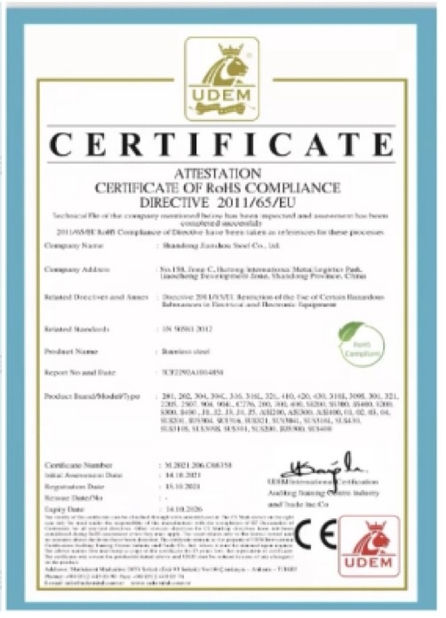-
Seamless Alloy Steel Pipe
-
Stainless Steel Seamless Pipe
-
Seamless Carbon Steel Pipe
-
Stainless Steel Pipe
-
SS Welded Tube
-
Stainless Steel Sheet Plate
-
Stainless Steel Coil Strip
-
Stainless Steel Bars
-
Stainless Steel Wire Rod
-
Carbon Steel Plate
-
Carbon Steel Coil
-
Carbon Steel Tubes
-
Carbon Steel Bar
-
Carbon Steel Wire
-
Alloy Steel Sheet
-
Alloy Steel Coil
-
Alloy Steel Bar
-
Alloy Steel Wire
QC Profile
![]()
Metallurgical
Metallurgical testing is used to determine the quality of steel by analysing the microstructure of a sample under a microscope. A section of the sample is firstly polished and then examined and different characteristics are produced through mixing the steel with other substances.
Hardness
Hardness is not a vital property of a material, but it is related to the elasticity and plasticity. The hardness value test helps to compare between the materials or treatments. These tests are usually performed by impressing a test specimen, which is resting on a rigid platform under a static load.
Hardenability
Hardenability determines the depth and distribution of hardness induced by quenching. Also known as the Jominy Test. A long sample is heated uniformly to the correct temperature before the sample is removed from the furnace and placed on a fixture where water contacts the bottom face of the sample. After 10 minutes, the sample is removed and the results should show a curve of hardness versus the distance from the quenched end.
Tension
A tension test runs at a constant load and temperature. The strength of the material is tested to ensure its ability to withstand external forces without breaking. By pulling on something, you can quickly determine how the material will react to forces being applied in tension.
Ductility
The ductility of a material is indicated by the amount of deformation that’s possible until it breaks. This can be determined by measuring the area of a sample that has been tested to failure.
Compression
Compression tests are performed on small cylinders, blocks or strips to determine the ability of the material and whether it can undergo large plastic deformations and its limits. Samples are placed between pressure plates and compressed.
Fatigue
This test is used to determine the behavior of the materials when subjected to reparations of fluctuating loads. Used to simulate stress conditions that’ll be developed in materials under normal service conditions. The fatigue limit is shown by counting the number of stress cycles applied in one direction and then another, until the steel breaks.
Impact
Impact tests are used to indicate the behavior of the materials when subjected to high rates of loading, usually bending, tension or torsion. A swinging pendulum of a fixed weight raised to a standard height is used to strike the sample and the weight of the pendulum times the difference in heights helps to indicate the amount of energy absorbed by the specimen.
Wear
Wear resistance is a complex test and usually applied to specific equipment designed to simulate actual service conditions. Various types of environmental testing are carried out to witness how the material reacts to actual conditions.
Corrosion
Corrosion tests involve the destruction of a material by chemical, electrochemical or metallurgical interaction between the environment and material. Various types of environmental exposure tastings are done to simulate actual use conditions.
Creep
Creep tests are used to determine the continuing change in the deformation of a material at elevated temperatures when stressed below the yield strength. A creep test is a tension test run at a constant load and temperature.
Machinability
Machinability is the ease with which metal may be machined and many factors are considered in arriving at machinability ratings which are expressed as a percentage in compassion with AISI 1112 steel, which is rated at 100%.
Radiography
Radiography of metals involves the use of x-rays and the short-wavelength electromagnetic rays that are capable of passing through large thicknesses of metal and are typically used to test casting and welded joints for shrinkage voids.
Magnetic Particle
Magnetic particle inspection is a method of detecting cracks, tears, seams, and inclusions in steel and iron. This method will detect any discontinuities just below the surface that are hard to spot with the naked eye.
Ultrasonic
Ultrasonic testing utilizes sound waves above the audible range and this non-destructive test employs electronically produced high-frequency sound waves to penetrate metals and other materials. It is used to detect and locate such defects as shrinkage voids, internal cracks, porosity and large non-metallic inclusions.
Planning and design
During the planning and design stage, quality control activities include defining quality standards, developing quality plans, and selecting quality materials and components.
Production and processing
During the production and processing stage, quality control activities include monitoring production processes, controlling product quality, and ensuring product safety and reliability.
Inspection and testing
During the inspection and testing stage, quality control activities include performing inspections and tests, analyzing test results, and ensuring product compliance with quality standards.
Customer service
During the customer service stage, quality control activities include handling customer complaints, providing after-sales support, and continuously improving product quality and service quality.
Data analysis and improvement
During the data analysis and improvement stage, quality control activities include analyzing quality data, identifying quality problems, and implementing improvement measures.




